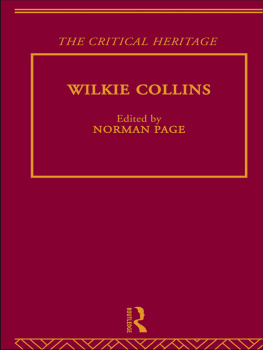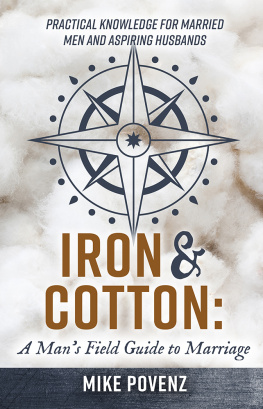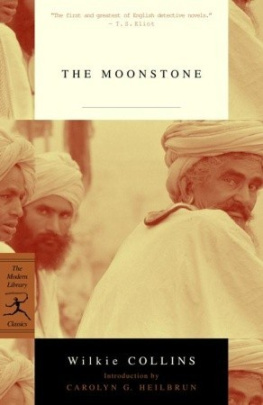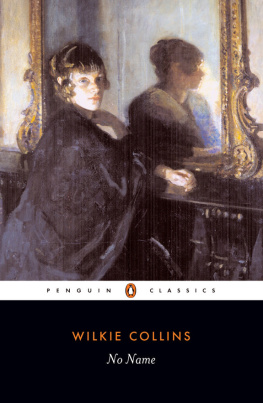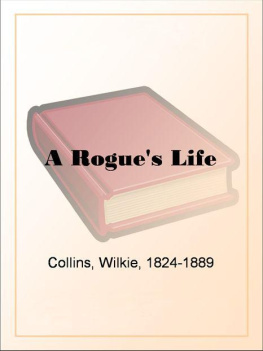OXFORD WORLDS CLASSICS
THE LAW AND THE LADY
WILKIE COLLINS was born in London in 1824, the son of a popular landscape painter. In 1846 he entered Lincolns Inn as a law student; in 1851 he was called to the bar, and in the same year met Dickens for the first time. Adopting literature as a profession and collaborating with Dickens, he contributed to Household Words and All the Year Round. Basil, his second novel, was published in 1852. Among his best-known works are The Woman in White (1860) and The Moonstone (1868). The original of the woman in white was Mrs Caroline Graves with whom Wilkie Collins lived for most of his life from 1859 until his death, though he had three children by Martha Rudd. He died in 1889.
JENNY BOURNE TAYLOR is Reader in English at Sussex University. Her publications include In the Secret Theatre of Home: Wilkie Collins, Sensation Narrative and Nineteenth-Century Psychology (London, 1988) and (with Sally Shuttleworth) Embodied Selves: An Anthology of Psychological Texts 18301890 (Oxford, 1998).
OXFORD WORLDS CLASSICS
For over 100 years Oxford Worlds Classics have brought readers closer to the worlds great literature. Now with over 700 titlesfrom the 4,000-year-old myths of Mesopotamia to the twentieth centurys greatest novelsthe series makes available lesser-known as well as celebrated writing.
The pocket-sized hardbacks of the early years contained introductions by Virginia Woolf. T. S. Eliot, Graham Greene, and other literary figures which enriched the experience of reading. Today the series is recognized for its fine scholarship and reliability in texts that span world literature, drama and poetry, religion, philosophy, and politics. Each edition includes perceptive commentary and essential background information to meet the changing needs of readers.
Refer to the to navigate through the material in this Oxford Worlds Classics ebook. Use the asterisks (*) throughout the text to access the hyperlinked Explanatory Notes.
OXFORD WORLDS CLASSICS

WILKIE COLLINS
The Law and the Lady

Edited with an Introduction and Notes by
JENNY BOURNE TAYLOR


Great Clarendon Street, Oxford OX2 6DP
Oxford University Press is a department of the University of Oxford.
It furthers the Universitys objective of excellence in research, scholarship,
and education by publishing worldwide in
Oxford New York
Auckland Bangkok Buenos Aires Cape Town Chennai
Dar es Salaam Delhi Hong Kong Istanbul Karachi Kolkata
Kuala Lumpur Madrid Melbourne Mexico City Mumbai Nairobi
So Paulo Shanghai Singapore Taipei Tokyo Toronto
Oxford is a registered trade mark of Oxford University Press
in the UK and in certain other countries
Published in the United States
by Oxford University Press Inc., New York
Editorial material Jenny Bourne Taylor 1992
Chronology Norman Page 1999
The moral rights of the author have been asserted
Database right Oxford University Press (maker)
First published as a Worlds Classics paperback 1992
Reissued as an Oxford Worlds Classics paperback 1999
All rights reserved. No part of this publication may be reproduced, stored in a retrieval system, or transmitted, in any form or by any means, without the prior permission in writing of Oxford University Press, or as expressly permitted by law, or under terms agreed with the appropriate reprographics rights organizations. Enquiries concerning reproduction outside the scope of the above should be sent to the Rights Department, Oxford University Press, at the address above
You must not circulate this book in any other binding or cover
and you must impose this same condition on any acquirer
British Library Cataloguing in Publication Data
Data available
Library of Congress Cataloging in Publication Data
Collins Wilkie, 18241890.
The law and the lady / Wilkie Collins; edited with an introduction by
Jenny Bourne Taylor.
p. cm.(Oxford worlds classics)
Includes bibliographical references.
I. Taylor, Jenny 1949 II. Title. III. Series.
PR4494.L39 1992 823 .8dc20 9142961
ISBN 019283679X
3 5 7 9 10 8 6 4
Printed in Great Britain by
Clays Ltd., St Ives plc
CONTENTS
INTRODUCTION
ALTHOUGH Wilkie Collins wrote over thirty books during a writing career which lasted from 1848 to 1889, until recently his reputation rested on only twoThe Woman in White and The Moonstone. Seldom if ever out of print since they first appeared in 1860 and 1868, these novels became established as classic examples of mid-nineteenth-century mystery and detective fictionas early specimens of a genre that was to come of age in the 1890s and the 1920s. As interest in Victorian sensation fiction has grown, however, other novels have come back into view. No Name (1862) and Armadale (1866) have both been republished in the last few years, and together the four novels confirm Collinss place as a writer who, as he put it in the Preface to Armadale, often oversteps, in more than one direction, the narrow limits within which [critics] are disposed to restrict the development of modern fiction.
The sensation novels of the 1860s owed their contemporary notoriety to the ways in which they blurred the boundaries between the strange and the familiarexploring what Henry James described as those most mysterious of mysteries, the mysteries that are at our own doors. But that pleasurable process of unravelling often revealed not a solution, but another set of questions and secrets that hinged on the protagonists position within the family. Sensation fiction is concerned with crime and deviance, but it doesnt work by simply tearing off a mask and revealing the criminal. It deploys intricate narrative structures to scrutinize how deviance is perceived and defined. It does not merely exploit the thrill offered by the image of the safe home being threatened from within or without; it breaks down the boundaries between those inner and outer, public and private, worlds.
We are now beginning to recognize the complexity of Collinss fiction, but the emphasis still tends to be confined to the novels of the 1860s. The consensus about his work as a whole is that the last twenty years of his life represented a steady decline, in quality if not in quantity (he published nineteen novels and volumes of stories after 1870). Various factors are held responsible for this decline. His close friend Dickens died in 1870. His health started to deteriorate rapidly after the publication of The Moonstone in 1868, and this was accompanied by his growing dependence on opium. His novels in general became much more explicit in their social commitment, dealing with topics as wideranging as domestic violence and the lack of control married women had over their property (Man and Wife), the condition of the fallen woman (The New Magdalen), Christian Socialism (The Fallen Leaves), and vivisection (Heart and Science). But Collins didnt investigate these issues by turning to recognizably naturalistic modeshe often exaggerated Gothic and melodramatic conventions, producing novels that appeared dissonant, heavy-handed, bizarre. Yet while his post-1870 work frequently lacks the sophistication of the earlier novels, this process of decline is less relentless than is often assumed. Much of his later work shows an attempt to write socially committed popular literature using the resources of the sensation novel, and illustrates the problems such a project encounters. And while his critical reputation had certainly declined by the mid-1870s, his mass popularity in both Britain and America continued till his death. As far as Collins was concerned he was able to sustain and develop his writing, despite increasingly poor health, throughout the 1870s and 1880sindeed the early 1870s were, financially, the most successful and stable years of his life.
Next page

